
The New Zealand mud snail is a species of very small freshwater snail with a gill and an operculum. This aquatic gastropod mollusk is in the family Tateidae.

Lymnaea stagnalis, better known as the great pond snail, is a species of large air-breathing freshwater snail, an aquatic pulmonate gastropod mollusk in the family Lymnaeidae. The great pond snail is a model organism to study parasitology, neurology, embryonal development and genetic regulation.

Bithynia leachii is species of small freshwater snail with an operculum, an aquatic prosobranch gastropod mollusk in the family Bithyniidae.
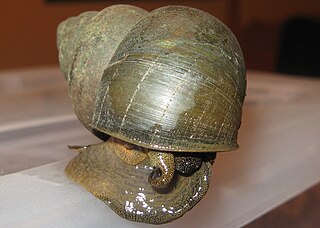
The Chinese mystery snail, black snail, or trapdoor snail, is a large freshwater snail with gills and an operculum, an aquatic gastropod mollusk in the family Viviparidae. The Japanese variety of this species is black and usually a dark green, moss-like alga covers the shell.
Fluvidona anodonta or more commonly known as the North Pine River freshwater snail is a species of minute freshwater snail that is endemic to Australia. Originally discovered in 1892 by Hedley & Musson, the snail is highly elusive and only has been sighted four times since its discovery. The snail is 2 mm long and 1 mm wide with the shell colouring being of a yellow-whiteish shade. Fluvidona anodonta resides within the Moreton Bay Region, specifically in four river systems within the D'Aguilar National Park, Queensland. The four river systems are the South Pine River headwaters, the North Pine River headwaters, Kobble Creek and Low Branch Creek. The snail is found under deeply submerged rocks within permanent freshwater systems.

Beddomeia hallae, also known as Buttons Rivulet hydrobiid snail, is a species of small freshwater snail that is endemic to Australia. The species is an aquatic operculate gastropod mollusk in the family Hydrobiidae. Beddomeia hallae belongs to the genus Beddomeia, which is the largest group in the family Hydrobiidae, consisting of 47 species. In the Threatened Species Protection Act 1995, this species is one of the 37 Beddomeia species listed as endangered, however, on the International Union for Conservation of Nature Red List, the species is listed as vulnerable. Found in Tasmania, in the streams of Buttons Rivulet and Castra Rivulet, Beddomeia hallae is sighted in its natural habitat amongst wood, leaves and under stones. Nonetheless, the Beddomeia species including Beddomeia hallae are geographically isolated, existing within restricted ranges.
Beddomeia waterhouseae, also known as Claytons Rivulet freshwater snail, is a species of freshwater snail in the family Tateidae. This species is endemic to northern Tasmania in Australia. The holotype specimen was found in a very small tributary of Little Clayton's Rivulet and is held at the Australian Museum. B. waterhouseae is small and as an adult has a shell measuring between 1.7 to 3.7 mm in length. The shell shape is ovate-conic to broadly conic and has a thin inner lip and no columellar bulge. This species feeds on algae and detritus on rocks. The female of the species lay single eggs in capsules made of sand grains and attached to the underside of rocks or wood. B. waterhouseae is considered vulnerable by the IUCN as it has a very small range and is sensitive to water quality and so may be threatened by disturbances of its habitat. Other threats include habitat loss. Conservation activities such as assessment of the aquatic ecosystem and vegetal surveys are being undertaken in an attempt to preserve this species.
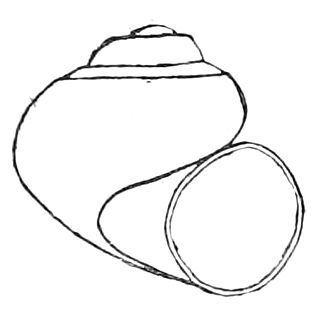
The Utah roundmouth snail, also known as the Utah valvata or desert valvata, scientific name Valvata utahensis, is a species of freshwater snail with a gill and an operculum, an aquatic gastropod mollusc in the family Valvatidae, the valve snails.
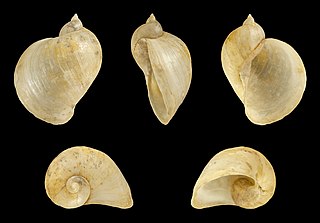
Radix auricularia, the big-ear radix, is a species of medium-sized freshwater snail, an aquatic pulmonate gastropod mollusk in the family Lymnaeidae.

Pleuroceridae, common name pleurocerids, is a family of small to medium-sized freshwater snails, aquatic gilled gastropod mollusks in the superfamily Cerithioidea.These snails have an operculum and typically a robust high-spired shell.
Metagonimoides oregonensis is a trematode, or fluke worm, in the family Heterophyidae. This North American parasite is found primarily in the intestines of raccoons, American minks, frogs in the genus Rana, and freshwater snails in the genus Goniobasis. It was first described in 1931 by E. W. Price. The parasite has a large distribution, from Oregon to North Carolina. Adult flukes vary in host range and morphology dependent on the geographical location. This results in different life cycles, as well as intermediate hosts, across the United States. On the west coast, the intermediate host is freshwater snails (Goniobasis), while on the east coast the intermediate host is salamanders (Desmognathus). The parasites on the west coast are generally much larger than on the east coast. For example, the pharynx as well as the body of the parasite are distinctly larger in Oregon than in North Carolina. The reverse pattern is observed on the east coast for uterine eggs, which are larger on the west coast. In snails, there is also a higher rate of infection in female snails than in males. Research on the life history traits of the parasites have been performed with hamsters and frogs as model species.

Elimia virginica, common names the Piedmont elimia or Virginia river snail, is a species of freshwater snail with an operculum, an aquatic gastropod mollusc in the family Pleuroceridae.
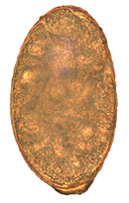
Nanophyetus salmincola is a food-borne intestinal trematode parasite prevalent on the Pacific Northwest coast. The species may be the most common trematode endemic to the United States.

Juga is a genus of freshwater snails with a gill and an operculum, aquatic gastropod mollusks in the family Semisulcospiridae.

Pyrgulopsis deserta is a species of freshwater snail in the family Hydrobiidae, the mud snails. It is known by the common names desert springsnail, Virgin springsnail, and St. George snail. It occurs in southwestern Utah and northwestern Arizona in the United States.

Freshwater snails are gastropod mollusks which live in fresh water. There are many different families. They are found throughout the world in various habitats, ranging from ephemeral pools to the largest lakes, and from small seeps and springs to major rivers. The great majority of freshwater gastropods have a shell, with very few exceptions. Some groups of snails that live in freshwater respire using gills, whereas other groups need to reach the surface to breathe air. In addition, some are amphibious and have both gills and a lung. Most feed on algae, but many are detritivores and some are filter feeders.
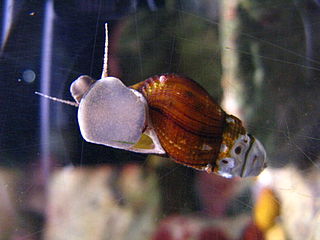
Semisulcospiridae, common name semisulcospirids, is a family of freshwater snails, aquatic gilled gastropod mollusks with an operculum, in the superfamily Cerithioidea.

Indoplanorbis is a genus of air-breathing freshwater snail. Its only member species is Indoplanorbis exustus, an aquatic pulmonate gastropod mollusk in the family Planorbidae, the ram's horn snails. The species is widely distributed across the tropics. It serves as an important intermediate host for several trematode parasites. The invasive nature and ecological tolerance of Indoplanorbis exustus add to its importance in veterinary and medical science.

Semisulcospira libertina is a species of freshwater snail with an operculum, an aquatic gastropod mollusk in the family Semisulcospiridae. Widespread in east Asia, it lives in China, Taiwan, Korea, Japan, and the Philippines. In some countries it is harvested as a food source. It is medically important as a vector of clonorchiasis, paragonimiasis, metagonimiasis and others.
Juga silicula, common name glassy juga, is a small, freshwater snail found lotic water in Washington, Oregon, and northern California. It is dark reddish-brown in color with an ovate operculum and about 3.5 whorls.

















